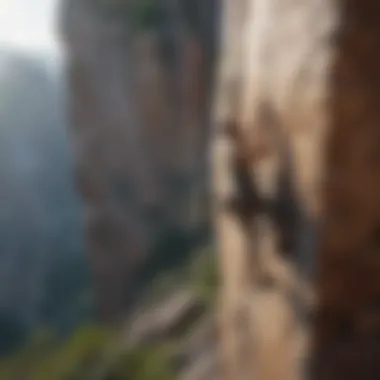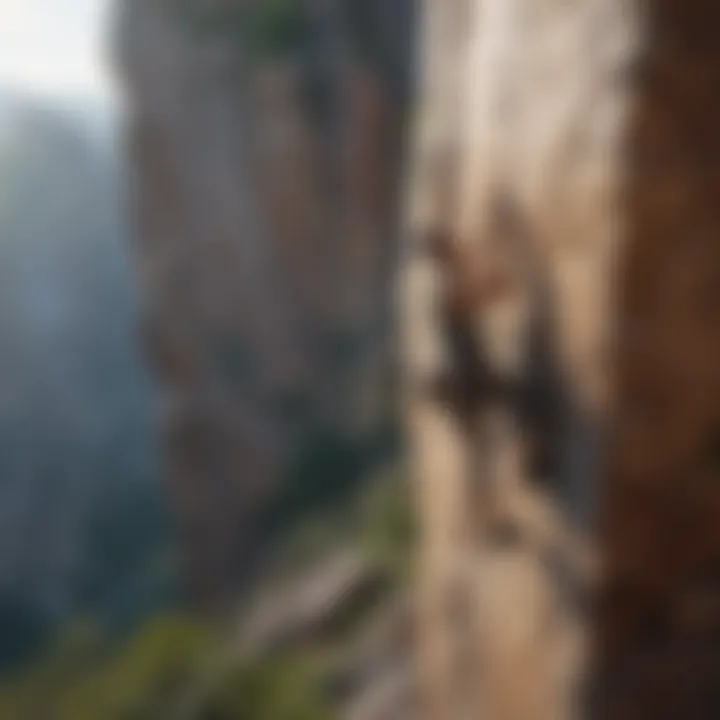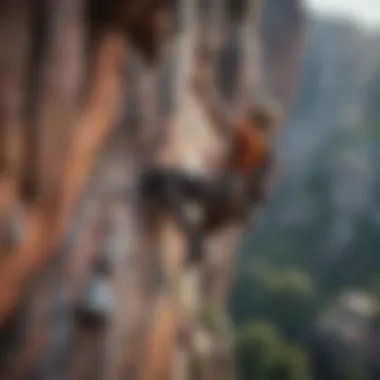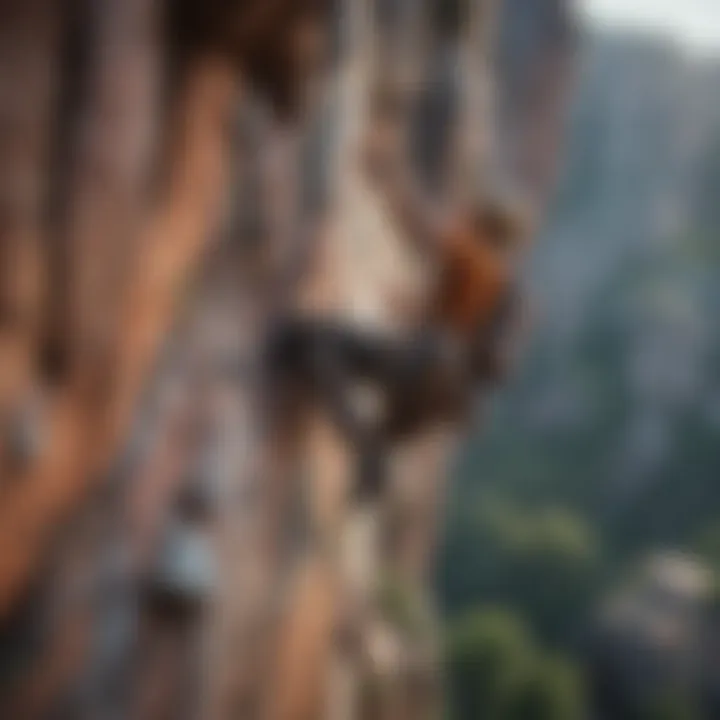Discovering Accessible Rock Climbing Venues for All


Intro
Rock climbing is not merely a test of physical strength; it’s a profound endeavor that connects individuals with stunning landscapes and unique communities. As thrill-seekers and adventure lovers venture into diverse rock climbing locations, understanding what makes a spot accessible becomes paramount. Whether you’re a novice eager to conquer your first vertical ascent or a seasoned climber exploring challenging routes, the climbing culture, safety concerns, and vital techniques can significantly influence your experience.
Accessibility in rock climbing transcends geographic convenience; it also encompasses the availability of routes that match various skill levels and the opportunities for learning and growth. As we delve into this guide, we aim to unearth the essentials—tips for skill development, the right gear, and the safety measures that will set the stage for thriving in the treetops and crags.
Techniques and Tips
Skill Development
Developing your climbing prowess involves a mix of practice, planning, and persistence. Start by choosing local climbing spots with routes that align with your current abilities. Community centers often hold workshops, and climbing gyms can serve as excellent training grounds before tackling outdoor cliffs. Engage with experienced climbers who can provide pointers, and don't shy away from asking for feedback. Remember, honing your patience is key—each ascent is a stepping stone towards mastery.
Practical Techniques
Here are a few practical techniques to incorporate into your climbing routine:
- Footwork Precision: Focus on how you place your feet; this can free up your hands for more complex moves.
- Body Positioning: Keep your body close to the rock, distributing your weight effectively.
- Breathing Rhythm: Cultivating a steady breathing pattern can reduce fatigue and help you stay calm during challenging climbs.
Common Mistakes to Avoid
Watch out for these pitfalls:
- Overgripping: This can tire you out quickly. Grip just enough to hold on.
- Neglecting Warm-Ups: Your body needs to be prepared. Always stretch before scaling upwards.
- Ignoring Gear Fit: Ill-fitted gear can affect your performance. Ensure your shoes and harness are comfortable.
Gear and Equipment
Essential Gear for Beginners
If you're starting, investing in quality gear is crucial. Essential items include:
- Climbing Shoes: These allow for better grip and control over foot placements.
- Harness: A comfortable harness that fits snugly ensures safety during climbs.
- Chalk Bag: Keeping your hands dry is key to maintaining grip.
Latest Innovations and Trends
Innovation in climbing gear continues to evolve. Lightweight carabiners, breathable fabrics in clothing, and advanced climbing shoes recently hit the market, enhancing both safety and comfort.
Reviews and Comparisons
It’s advisable to compare brands before purchase. Popular options include La Sportiva for shoes and Black Diamond for harnesses. Explore user reviews on platforms like reddit.com to find what works best for you.
Safety Measures
Essential Safety Gear
Safety gear is non-negotiable in climbing. Key items include:
- Helmets: Protect your head from potential rockfalls.
- Belay Devices: Essential for controlled descents and safety.
- First Aid Kit: Always be prepared for minor injuries.
Best Practices for Safe Participation
To ensure safety while climbing, adhere to these best practices:
- Check Gear Regularly: Inspect your equipment before each climb.
- Use Proper Technique: Focus on technique to avoid falls.
- Communicate: Clearly signal to your climbing partner about your next moves.
Injury Prevention and Management
Injuries can occur, but they can often be prevented. Warm up before each climb and listen to your body. If an injury does happen, knowing how to treat it—such as R.I.C.E. (Rest, Ice, Compression, Elevation)—can make all the difference.
Spotlights on Extreme Sports
Featured Sport of the Month


This month, we shine the spotlight on bouldering—the art of climbing without ropes on shorter walls typically under 20 feet.
Profiles of Prominent Athletes
Check out profiles of athletes like Adam Ondra and Alex Honnold, who have made significant strides in the climbing community. Their stories not only inspire but also offer insights into what it takes to excel in this demanding sport.
"Climbing pushes your limits not only physically but also mentally. It's about finding that connection with nature while challenging yourself."
By navigating through climbing techniques, gear essentials, safety measures, and the vibrant community surrounding the sport, this guide aims to pave the way for both new and seasoned climbers, ensuring every ascent is a memorable experience.
Understanding Rock Climbing
Rock climbing is more than just a sport; it's a journey that combines physical endurance, problem-solving skills, and a profound connection with nature. Understanding the intricacies of rock climbing is crucial not only for enthusiasts at the start of their climbing adventure but also for seasoned climbers who want to refine their skills and knowledge. This foundational comprehension serves as a launchpad into the diverse world of climbing, where each ascent presents a unique challenge, requiring both mental and physical agility.
Definition and Types of Rock Climbing
At its core, rock climbing involves ascending natural rock formations or artificial rock walls. It sounds simple, but the terrain varies widely, leading to distinct types of climbing. Traditional climbing, or "trad" climbing, relies on placing gear into the rock for protection, demanding a strategic mindset. On the other hand, sport climbing emphasizes fixed anchors, like bolts, making for more straightforward ascents, especially for novices.
Additionally, bouldering is a climbing discipline focusing on short, yet intense, climbs without the use of ropes or harnesses. This form highlights power and technique and is often practiced in climbing gyms or outdoor spots like boulders and cliffs. Finally, there's alpine climbing, which corresponds to summiting mountains and typically combines rock, snow, and ice, presenting a whole different ball game altogether. By recognizing these varied types, climbers can choose their preferred style, enhancing the overall experience.
Equipment Required for Rock Climbing
Venturing into rock climbing necessitates the right tools. Safety and performance hinge on quality gear. For beginners, essential items include:
- Climbing Shoes: Tight-fitting footwear designed for grip & support.
- Harness: A snug belt that wraps around your body, providing attachment points for your rope.
- Chalk Bag: Keeps your hands dry, improving traction on holds.
- Rope: Dynamic ropes are elastic, designed to absorb falls and reduce impact.
- Carabiners: Metal loops with spring-loaded gates used for connecting components of your rigging.
For specialized climbing, further gear may be needed. For instance, trad climbers need protection gear like nuts and cams, while boulderers might benefit from crash pads to cushion falls. This equipment ensures climbers remain secure while pushing their limits.
Benefits of Rock Climbing
The perks of rock climbing extend far beyond physical fitness. Here are several profound benefits:
- Reconnect with Nature: Climbing traditionally happens outdoors, fostering an appreciation for the environment.
- Physical Fitness: Engaging various muscle groups, it enhances strength, flexibility, and endurance.
- Mental Toughness: Climbing requires focus and problem-solving, improving mental resilience.
- Community Engagement: Many climbers form lasting friendships through local climbing groups and events.
"Rock climbing transforms the landscape of challenge into that of achievement, where every hold is an opportunity to rise higher."
Overall, understanding the fundamentals of rock climbing lays down the groundwork for safe practice while enhancing enjoyment. Each climb is a fresh opportunity to explore, invite discomfort, and ultimately, savor the sweet rewards of perseverance.
Finding Climbing Locations
Finding the right location to climb isn't just a matter of convenience; it's where the thrill meets safety and natural beauty intertwines with adventure. An optimal climbing venue can make or break the experience. Think about it: you wouldn't want your first ascent under the scorching sun, or on slick rocks—talk about a recipe for disaster! This section lays out the importance of finding climbing locales that suit various skill levels and preferences while keeping an eye on safety and environmental factors.
Factors to Consider When Choosing a Location
When chasing the adrenaline rush of climbing, several factors come into play while selecting a location. The right choice often revolves around your skill set, experience, and the type of climbing you opt for. Here’s what to keep an eye on:
- Skill level: Whether you’re just starting or a seasoned rock-hopper, it’s crucial to match the location to your ability. Beginners might prefer spots with easier routes and ample foot-pegs, while advanced climbers often search for challenging faces.
- Climatic conditions: Weather can change the game entirely. Locations that are prone to sudden weather shifts can jeopardize your safety. Always inspect forecasts beforehand, as climbing in adverse conditions can be risky.
- Access and amenities: Some climbing areas are remote with little to no access to facilities. Check if you’ll need to hike several miles to the rock face or if there are parking spaces near the entry point. Bathrooms and water availability can also make a big difference, especially for longer stints on the wall.
- Security and regulation: It’s wise to be up on any regulations tied to the climbing site. Some areas might require permits, or have specific guidelines to protect both climbers and natural habitats. It’s always smart to stay on the good side of the environmentalists!
No matter what your experience is, these factors shape your climbing journey, making it essential to weigh them against what you’re hoping to achieve.
Researching Local Climbing Areas
Once you settle on the factors above, it’s time to dig deeper. Research suited resources can provide heaps of information on local climbing areas. Take heed of these tips:
- Guidebooks and online resources: Check out climbing guidebooks specific to your region. They often contain valuable details, including route ratings, rock types, and unique formations worth checking out. Websites like Reddit have communities where climbers share personal experiences and recommendations, making it ideal for digging up lesser-known spots.
- Climbing forums and groups: Engaging with local climbing clubs or using platforms like Facebook can introduce you to like-minded individuals and provide inside information that’s difficult to find elsewhere.
- Visit in person: Whenever feasible, planning a preliminary visit can give a real taste of the climbing area. Assess the landscape, evaluate footing and safety, and see if the vibes match what you're looking for. You might discover hidden gems that weren’t mentioned online.
These steps in researching local climbing areas not only ensure you pick the best locations but can also open the door to a welcoming climbing community.
Popular Climbing Venues in Your Area
Understanding popular climbing venues in your area serves as a bedrock for anyone keen on exploring rock climbing. The right venue can make or break your adventure; if you pick a spot that doesn't fit your skill level, you might find yourself feeling more frustrated than exhilarated. This section explores various types of climbing locations meant to cater to varying abilities and preferences whilst ensuring a thrilling experience.
Urban Climbing Locations


Urban climbing spots have gained traction over the years, allowing thrill-seekers to find adventure right in their city. What’s appealing about these settings is the convenience they offer. Packed with incredible structures, cityscapes become the playground for climbers.
These locations often feature:
- Built-In Climbing Walls: Many urban parks now incorporate climbing walls where both beginners and advanced climbers can hone their skills. They may include bouldering areas or routes that mimic outdoor climbing challenges.
- Community Events: Urban climbing spots frequently host events or competitions, fostering a vibrant climbing culture. These gatherings allow climbers to connect, share tips, and even tackle climbs together.
- Accessibility: With public transport options abound, these locations are easy to reach. Whether it’s after work or during the weekend, spontaneity is a click away.
"Embrace the urban jungle; it’s where concrete meets your climbing aspirations!"
However, the main challenge is that urban climbing spots can become crowded, especially during peak hours. But, that just adds to the community vibe, doesn’t it?
Natural Parks with Climbing Opportunities
Natural parks are like the holy grail for climbers, providing breathtaking views and diverse terrains. They offer an escape from the hustle and bustle of city life while allowing climbers to experience nature’s raw beauty directly. These locations usually feature:
- Variety of Routes: From beginner-friendly trails to challenging ascents, natural parks cater to climbers of all skill levels.
- Wildlife Viewing: Climbing in nature isn’t just about the exercise; it’s also about appreciating the environment. Spotting a hawk glide overhead or catching the dawn chorus can really enhance the experience.
- Education and Preservation: Many parks have resources and workshops aimed at educating climbers on sustainable practices, ensuring that nature is preserved for generations to come.
It’s crucial to check for required permits or regulations, as some areas have restrictions. Respecting the local flora and fauna is paramount; after all, it’s their home.
Indoor Climbing Gyms
For those rainy days or when the weather isn’t on your side, indoor climbing gyms provide a controlled environment to practice and enhance skills without the unpredictability of the outdoors. These gyms often feature:
- Climate Control: No need to worry about rain, snow, or heat; indoor climbing stays comfortable year-round.
- Varied Routes: Climbing walls are reset frequently, offering new challenges regularly. It keeps the experience fresh.
- Coaching and Classes: Many gyms offer beginner classes or personal coaching, giving new climbers essential techniques without the fear of high altitudes.
- Community Vibes: Just like urban venues, indoor gyms foster a sense of community. Solo climbers often find companions through groups and meetups.
The downside? Indoor climbing can’t quite replicate the thrill of summiting a mountain or scaling a rock face under the open sky. But for many, it’s a fantastic stepping stone.
Climbing Safety and Best Practices
When it comes to rock climbing, safety is not just a suggestion; it’s the backbone of every successful adventure. Many climbers, especially beginners, might find the thrill of scaling a cliff enticing, but overlooking safety measures can turn an exhilarating climb into a dangerous situation. Ensuring safety in rock climbing is about more than just minimizing risks; it maximizes enjoyment and allows individuals to focus on their climbing experience, rather than on potential dangers. Here, we will cover essential safety gear and techniques that contribute to a secure climbing experience.
Essential Safety Gear
Climbing without proper gear is like sailing without a life jacket. Below are some essentials that every climber should consider:
- Climbing Harness: This forms the core of your safety setup. It keeps you securely attached to the rope and distributes the force during a fall.
- Helmet: Rocks can fall, and head injuries can be fatal. A good helmet absorbs impact and shields against any potential debris.
- Climbing Shoes: These are designed for grip. Fit them snugly for optimal control and performance during your climb.
- Rope: Choose climbing ropes that are durable and appropriate for your discipline. Be sure it’s rated for your weight and climbing style.
- Carabiners: Used to connect various pieces of equipment or to secure yourself to an anchor.
- Belay Device: This tool is used to manage the rope to catch falling climbers effectively.
Equipping yourself with good gear is one thing, but understanding how to use it is another. Proper education about your equipment maximizes their potential to keep you safe.
"Preparation is the key to safety in climbing; being equipped and knowledgeable can turn a risky outing into a thrilling experience."
Climbing Techniques for Safety
Having the right gear makes a huge difference, but solid techniques make for a secure climbing experience. Here are some techniques climbers can adopt:
- Climbing with a Buddy: Always climb with a partner. Not only is it safer, but you can also look out for each other, which is vital when transitioning between different climbing styles.
- Proper Rope Management: Keep your rope untangled and avoid knots that can snag during your ascent. Always ensure there’s enough slack, but not too much that it becomes dangerous.
- Communication: Maintain clear communication with your climbing partner. Using designated terms for belaying, climbing, or resting can prevent miscommunication during critical moments.
- Mind the Fall Zone: Always be aware of the potential fall zone. Knowing where you can expect to land in case of a slip helps minimize the risk of hitting sharp rocks or other hazards.
- Focus on Footwork: Many climbers place too much emphasis on strength, neglecting technique. Precise footwork can conserve energy and stability.
Understanding and practicing these techniques can develop a more instinctive safety awareness. By making safety a priority and incorporating these best practices, climbers can truly enjoy what the rock climbing experience has to offer.
Climbing Communities and Resources
Climbing is more than just scaling rocks; it's about the community that forms around the sport. Climbing communities serve as a backbone for enthusiasts at various skill levels, providing support, camaraderie, and shared knowledge. These groups contribute to a richer climbing experience, enhancing local climbing culture while fostering environmental stewardship. Whether you're a novice or a seasoned climber, engaging with these communities offers numerous benefits that elevate the overall climbing journey.
Joining Local Climbing Groups
Getting involved with local climbing groups can be a game changer. These groups often organize regular meet-ups, skill shares, and outings that allow climbers to connect, learn, and share experiences. The benefits are manifold:
- Networking: Meeting fellow climbers can lead to new friendships and potential climbing partners.
- Mentorship: More experienced climbers can offer guidance, helping you refine your skills and techniques in a supportive environment.
- Community Events: Many groups host events that combine climbing with conservation efforts, increasing awareness about responsible climbing practices and sustaining the local ecosystem.
For instance, joining a group like the American Alpine Club can provide access to a wealth of resources such as guided climbs, mentorship programs, and even discounts on gear.
“One doesn’t climb to reach the top, but to enjoy the view, the journey, and the company along the way.”
Online Platforms for Climbers


In today's digital age, climbing communities are not restricted to just local meet-ups. Online platforms have become essential gathering spots for climbers worldwide. Websites like Reddit's r/climbing serve as forums where climbers can exchange tips, share their experiences, and discuss gear.
Consider these online avenues:
- Forums: Engaging in conversations on platforms like Reddit or specialized forums helps climbers gain insights into various climbing locations and techniques.
- Social Media: Follow climbing groups on Facebook or Instagram to stay updated on events, new climbing spots, and trends in the climbing community.
- Apps: Utilize climbing apps which often feature route databases, community photos, and user-generated content showcasing diverse climbing experiences.
By tapping into these resources, climbers can enhance their skills and discover new opportunities—all from the comfort of their home.
Engaging in climbing communities, whether online or offline, not only enriches individual skills but also strengthens the collective commitment to preserving our climbing environments.
Environmental Considerations
When embarking on the exhilarating adventure of rock climbing, it is essential to consider the environmental impact of this sport. Climbers often tread lightly on nature’s shoulders, but awareness and action can ensure that these beloved locations remain untouched, or at least less affected, by human presence. In this section, we will delve into the significance of environmental considerations in rock climbing, spotlighting sustainable practices and the impact climbing has on natural habitats.
Sustainable Climbing Practices
Sustainability in climbing isn’t just a buzzword; it’s a necessity. Integrating responsibility into your climbing routine is crucial for protecting the locations you love. Here are some ways to embrace sustainability:
- Leave No Trace: Always carry out what you bring in, including food wrappers, tape, and gear. The fewer remnants you leave, the better.
- Climb on Designated Routes: Stick to marked trails and climbing routes. This minimizes habitat disruption and protects sensitive areas.
- Choose Eco-Friendly Gear: Consider gear that is made with sustainable practices in mind. Brands like Black Diamond and Petzl are known for their efforts to reduce environmental impacts.
- Respect Wildlife: Steer clear of nesting areas and seasonal closures. Knowledge of local fauna can help you avoid harming vulnerable species.
Adopting these practices won’t just help preserve nature; it can also enhance the climbing experience. Being a responsible climber strengthens the connection to the environment and fosters a deeper appreciation for the great outdoors.
Impact of Climbing on Natural Habitats
Every climb can leave a mark, both good and bad. Understanding the impact of rock climbing on natural habitats is important for both individual climbers and the wider climbing community. Here are some key considerations:
- Soil Erosion: Frequent foot traffic in climbing areas can lead to soil compaction and erosion. The best way to mitigate this is by using established trails and staying off sensitive terrains.
- Vegetation Damage: Climbing can impact vegetation in fragile ecosystems. Trampling can lead to loss of plant life, which provides essential habitat for local fauna.
- Wildlife Disturbance: Climbing in certain areas - particularly those with protected or endangered species - can disrupt their natural behaviors. Awareness of wildlife patterns is essential to minimizing disturbances.
"When we think of climbing, it’s easy to focus on the thrill. However, climbers should recognize the critical balance between adventure and nature preservation.”
The bottom line is that climbers hold significant power to either preserve or destroy the natural world they explore. By making mindful choices and encouraging others to do the same, we can enjoy climbing while safeguarding the very places that fuel our passion.
Developing Skills and Techniques
Climbing isn’t just about reaching the top; it’s a dance with the rock, a conversation between you and nature. Being adept at climbing techniques can make this interaction safer and more pleasurable. For individuals particularly interested in forging their path in this exhilarating sport, honing skills is essential. This section outlines why skill development matters and how you can achieve it effectively.
Training for Climbers
When it comes to training, a thoughtful approach is vital. It goes beyond merely building upper body strength or mastering a few grips. Here are several key focus areas every climber should keep in mind:
- Endurance: Long climbs demand stamina. Consider activities like bouldering, which not only challenges your strength but also your ability to keep moving even when the muscles begin to fatigue. Incorporating interval training can also benefit you in the long haul.
- Technique Work: This can't be stressed enough. Good footwork, balance, and body positioning reduce your energy consumption significantly. A monthly focus on specific techniques, such as heel hooking or flagging, can elevate your climbing game.
- Mental Preparation: A strong mind is just as important as a strong body. Visualization techniques, for example, can help climbers manage anxiety associated with high-altitude challenges. Consider slowing down and mentally mapping your route before each climb.
"The best climber in the world is the one who’s having the most fun." – Alex Lowe
A structured training plan that emphasizes these areas can build a solid foundation. There are many resources available—online forums like reddit.com/r/climbing offer community insights and training tips, while facebook.com groups connect you with local climbers willing to share their experiences.
Climbing Classes and Tutorials
For those who prefer guided learning, climbing classes can be a game-changer. These offer structured instruction, which is especially beneficial for novices or even those looking to refine their approach. Here’s what to consider:
- Choosing the Right Class: Look for courses tailored to your skill level. Many climbing gyms offer beginner and advanced classes. If you’re in a natural setting, check whether organizations host workshops in your area.
- Qualified Instructors: Research the qualifications of the teaching guides. Experienced climbers who know the ins and outs of safety procedures and climbing techniques can significantly enhance your learning experience. Their firsthand knowledge can be invaluable.
- Tutorial Resources: Aside from classes, plenty of tutorials are available online. Websites like britannica.com provide valuable educational resources that cover various facets of climbing.
In culmination, whether you are pounding the pavement at a rock climbing gym or venturing into wild terrain, dedicating time to develop your skills shapes not just how well you climb, but how much you enjoy the journey. Building skills means adapting to the unforeseen—an invaluable trait for any climber. So, get out there, find a class, and embrace the challenge ahead!
Ending
As we wrap up this vibrant discussion on rock climbing, it’s crucial to emphasise the role accessible climbing locations play in broadening the sport's appeal. Accessible venues not only foster participation among people of all skill levels but also nurture a community of climbers. This community aspect is vital for sharing experiences, learning from one another, and enhancing overall safety practices.
The Future of Climbing in Local Areas
The trajectory of rock climbing in local areas holds promise, largely thanks to ongoing efforts to promote inclusivity and accessibility. In many regions, there is a grassroots movement aimed at developing climbing areas that cater to diverse groups, including beginners and climbers with disabilities. These local initiatives demonstrate how climbing can be a truly outdoor experience that transcends barriers.
"It’s not just about reaching the summit; it’s about the journey and the camaraderie formed along the way."
As climbing gyms become more community-driven and offer varied programs—from adaptive climbing sessions to introductory workshops—the door opens wider for new enthusiasts. By synergising skills from experienced climbers with fresh perspectives from newcomers, the local climbing culture is enriched.
- Promotion of Sustainable Practices: Future climbing areas are also focusing on sustainable practices, ensuring natural spaces are preserved for generations to come.
- Liaison with Local Authorities: Climbing communities are increasingly liaising with local governments to create or enhance climbing facilities that align with environmental conservation efforts.
- Focus on Technology Integration: As technology continues to evolve, we see the rise of apps and online platforms designed to connect climbers with local venues, track their climbs, and share tips, fostering an interconnected world of adventure enthusiasts.
In essence, the future of climbing in local areas is not just about the rocks and routes. It’s about building a supportive network, sharing our love for the sport with others, and ensuring our natural landscapes remain unspoiled. With the right approach, the sport can thrive while forging healthy bonds among climbers and the environments we cherish.







